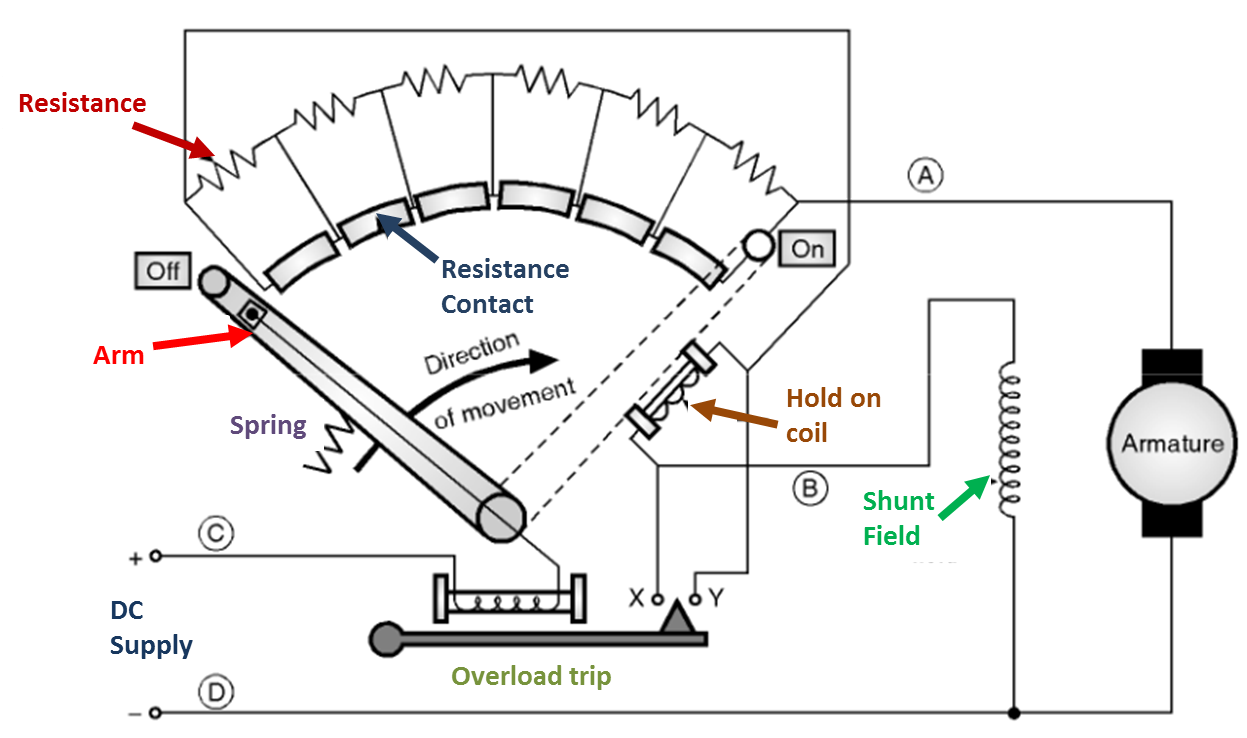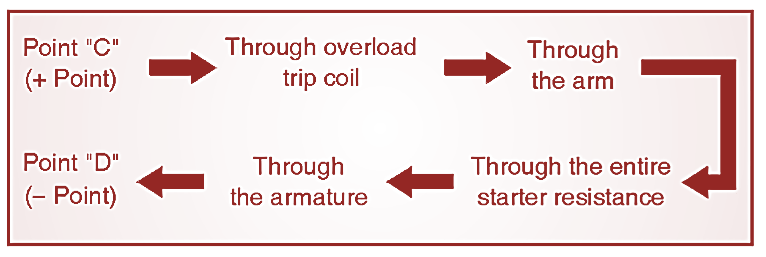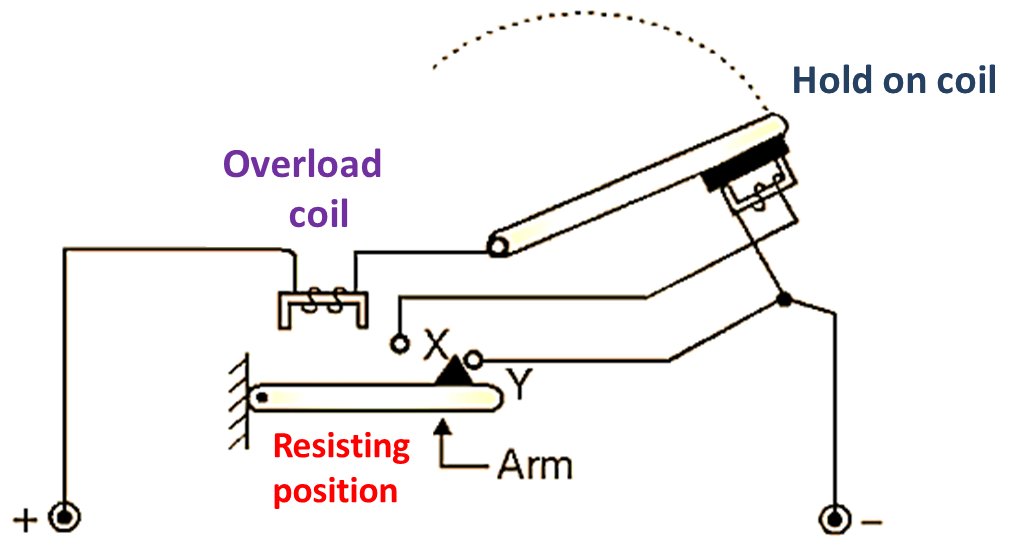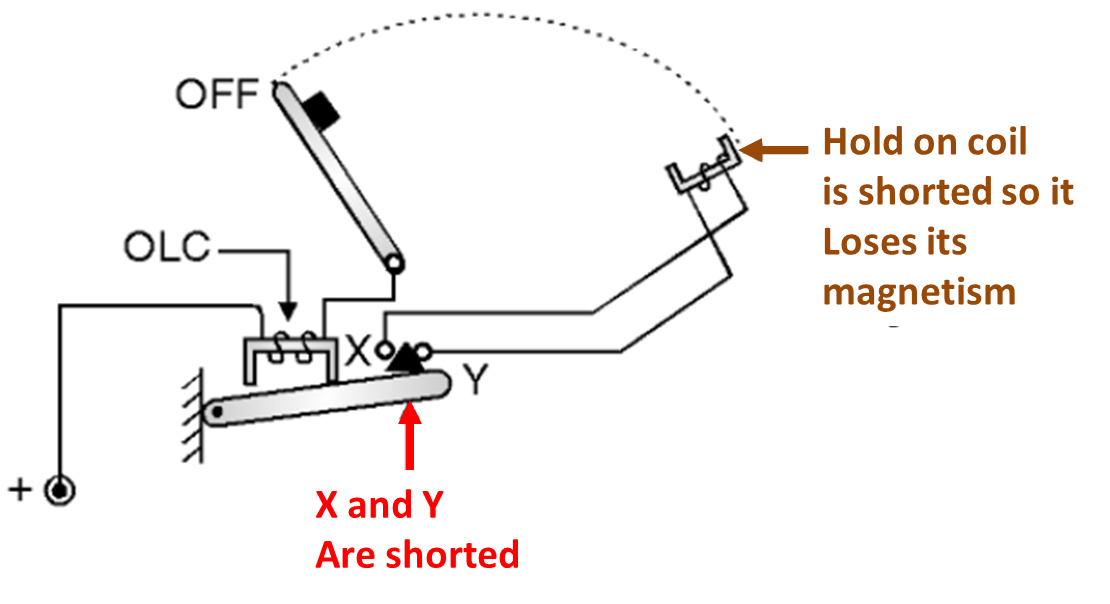A two point starter (or 2 Point Starter) is used for starting of a DC series motor.

Fig. 1: 2 Point Starter
Function of 2 Point Starter
The basic function of a two point starter is to protect DC series motor from high starting current. It does so by limiting the high starting armature current to a safe value by connecting a resistance in series with the armature only at the time of starting. This resistance is reduced gradually as the motor gains speed.
Construction of 2 Point Starter
Fig. 1 shows the construction of a two point starter. It is called as a two point starter because only two points are brought out for the external connections. There are two coils namely the overload trip coil and hold on coil, a spring controlled arm and a resistor which is divided into a number of sections. A DC series motor is connected between points A and B of the starter as shown. We can move the arm from OFF to ON position manually. The spring attached to this arm can bring it hack to the OFF position either when the motor is to he stopped or when power failure takes place.
Working of 2 Point Starter
At the time of starting:
At the time of starting, the DC power supply is turned on while the starter arm is in the OFF position. The armature current follows the path shown below:

Fig. 2 : Current flow at the time of starting.
Fig. 2 shows that the armature current flows through the entire starter resistance, thus limiting its value to a low safe value.
Field supply:
Point C (+ point of DC supply) is connected directly to the field winding via the overload coil and the hold on coil. Thus the DC supply gets connected directly without any starter resistance.
How to start the motor:
The moving arm of the starter is moved gradually in the clockwise direction from OFF position to the ON position. Due to this arm movement, the starter resistance appearing in series with the armature reduces gradually to increase the armature current in a gradual manner. When the starter arm reaches the ON position, the entire starter resistance is cut out and the motor starts running at the normal speed. Thus the motor is started in a safe manner.
Function of Hold on Coil
Now let us see the operation of the hold on coil. The field current flows through the hold on coil and it starts acting as an electromagnet. So when the arm is moved manually to the ON position, the soft iron piece on the handle experiences a force of attraction as shown in Fig. 1. Thus once the handle reaches the ON position, it remains there due to the magnetic force of attraction produced by the hold on coil. Whenever the supply fails, the current flowing through the hold on coil goes to zero. So it loses its electromagnetic properties and the arm returns hack to the OFF position under the influence of the spring. This will switch off the motor. Now when the supply is applied again, the whole starter resistance appears in series with the armature and we have to start the motor again by using the starter as explained earlier. Thus the entire starter resistance appears in series with the armature every time an attempt is made to start it. If the supply voltage goes below a particular level then the current through hold on coil will be very small and it will lose its electromagnetism. This will release the handle and the handle will return to the OFF position.
Function of the Overload Coil
Let us now discuss the function of the overload coil. The overload coil is an electromagnet. The motor current Ia passes through this coil.
Operation under normal condition
Refer Fig. 3(a) which shows the equivalent circuit under the normal operating condition. Below the overload coil there is an arm which is fixed at its fulcrum and it is resting in the horizontal position under the normal condition as shown in Fig. 3(a).

(a) Under normal operating condition.

(b) When overloading takes place.
Fig. 3 : Function of overload coil
Operation when the overloading takes place
When the motor current crosses a predetermined limit, the overload condition is said to have occurred. The current flowing through the overload coil will produce a force of attraction, which will lift the arm upwards as shown in Fig. 3 (a). This will lift the triangular iron piece and the points X and Y are connected to each other through it as shown in Fig. 3 (b). As points X and Y are shorted, the hold on coil is short circuited, the voltage across it reduces to zero. The hold on coil will lose its magnetic properties and the handle is returned back to the off state. Thus the motor is protected if it draws an excessive current from the source.